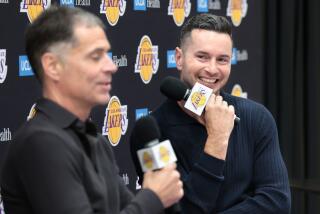Mark Landsberger, immortalized by Dr. J, played in ‘Showtime’ Lakers’ background
Mark Landsberger, apropos of his modest NBA career, makes only a barely noticed cameo in one of the most frequently replayed video highlights in NBA history.
That’s Landsberger, in his No. 54 Lakers jersey, tracking Julius Erving at the baseline as the Philadelphia 76ers forward prepares to take flight in the NBA Finals.
As Dr. J palms the ball in his right hand and majestically soars toward the basket, lowering the ball below his waist from behind the backboard before lifting it again and kissing it off the glass on the left side, Landsberger all but fades from view.
“He hung up there so long,” Landsberger says, “I was already down by the time he got to the other side.”
Landsberger’s time with the Lakers played out similarly.
Presaging the blue-collar sidekick role later made famous by Kurt Rambis, Landsberger mostly blended into the background as Magic Johnson, Kareem Abdul-Jabbar and Jamaal Wilkes took starring roles at the dawn of the Lakers’ “Showtime” era.
A 6-foot-8 reserve forward, the former Arizona State star helped the Lakers win championships in 1980 and ’82 while forging a reputation as a relentless rebounder.
“I was a guy with not a lot of athletic ability,” Landsberger notes, “but I had a great nose for the ball.”
That should have been enough to keep him on an NBA roster for years, he says, but he frittered away the opportunity.
“I could have done a lot more, but I was too wild,” Landsberger, 55, says from his home in St. Cloud, Minn., where he lives with his elderly parents and works as an oven operator at the Pan-O-Gold Baking Co. “I partied too much. Those were wild times in the NBA.... And, being honest, I was just too wild chasing girls.”
Released by the Lakers in 1983 — after a third NBA Finals appearance — Landsberger was out of the NBA a year later and played his last nine professional seasons overseas: six in Italy and one each in Greece, Spain and Argentina.
“I was happier once I went to Italy and could play 40 minutes a game,” he says. “It’s not like the NBA, but I enjoyed playing. I was a starter. I wasn’t the third or fourth wheel.”
That, of course, was never the case with the Lakers.
Landsberger, who led Allan Hancock College of Santa Maria to the state community college championship in 1974, was a second-round pick of the Chicago Bulls in 1977.
In February 1980, he was traded to the Lakers.
“That was a blessing, really, a total dream,” he says. “I was very surprised because they had a deep bench.”
Three months later, at the Spectrum in Philadelphia, he watched as Erving flew past in Game 4 of the NBA Finals.
“That was an unbelievable move,” Landsberger says. “Magic said it was the best move he’d ever seen.”
Landsberger has fonder memories of the last two games of the 1980 Finals, specifically Abdul-Jabbar’s grit in playing through an ankle injury in Game 5 and, in Abdul-Jabbar’s absence, Johnson’s well-documented all-around brilliance in Game 6.
“His ankle was as big as a baseball,” Landsberger says of Abdul-Jabbar. “But he played that fourth quarter — on one leg, really — and that showed me what kind of heart that guy had. I don’t think any player would do that today.”
Of Johnson, who had 42 points, 15 rebounds and seven assists in the title-clinching victory, he says, “He could have been the best power forward in the NBA. That’s how versatile he was.”
Landsberger’s 10 rebounds in the clincher went virtually unnoticed, which was typical.
His blue-collar efforts were most appreciated by coaches.
“He was more or less a specialist,” says Bill Bertka, longtime Lakers scout and former assistant coach. “Mark wasn’t a great offensive player, but for his role with us, he was perfect because any time he went in the game, he gave us energy.”
“I don’t like to use the term ‘garbage player,’ but he picked up all the trash – and then some,” Bertka says. “Probably per minute, he’s one of the best offensive rebounders that ever played the game.”
Landsberger later became expendable, however, after the Lakers added more well-rounded forwards such as Bob McAdoo, Mitch Kupchak, James Worthy and Rambis.
“When I wasn’t playing as much, I started partying more,” he says. “The L.A. scene was real tempting, but once I got to Italy, I stopped all that. That’s why I was so successful over there. I realized it was my last chance.”
Landsberger played 16 pro seasons in all, averaging about six points and six rebounds a game in seven NBA seasons.
Divorced before heading overseas — he has no children — he settled in Phoenix after he stopped playing, going into business as co-owner of a restaurant and a jewelry store-pawn shop.
About six years ago, the North Dakota-born graduate of Mounds View High in Arden Hills, Minn., returned to his Midwestern roots to help care for his parents and resume working.
Though he has never seen Staples Center, he still follows the Lakers and stays in shape playing pickup basketball.
He acknowledges that Erving could still leap over him.
“My vertical’s about one inch now,” he says.
More to Read
Go beyond the scoreboard
Get the latest on L.A.'s teams in the daily Sports Report newsletter.
You may occasionally receive promotional content from the Los Angeles Times.










